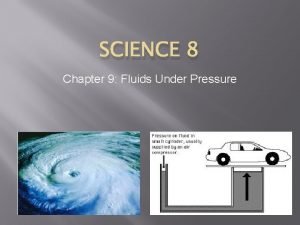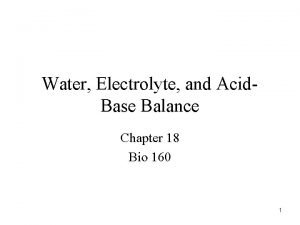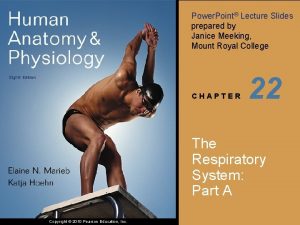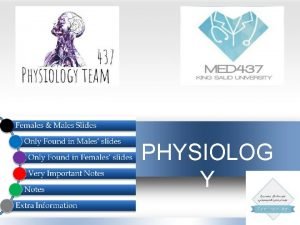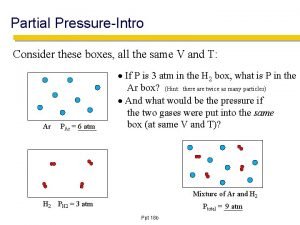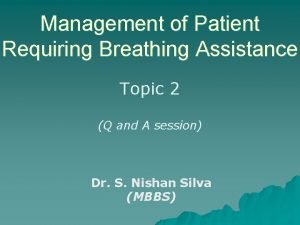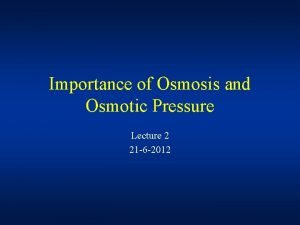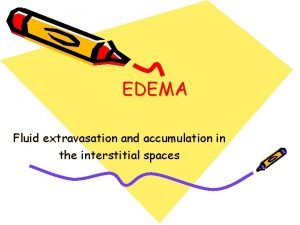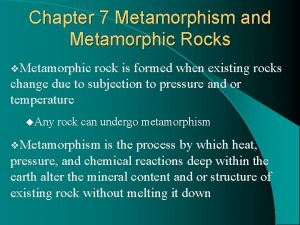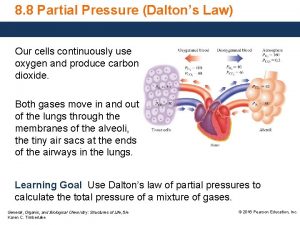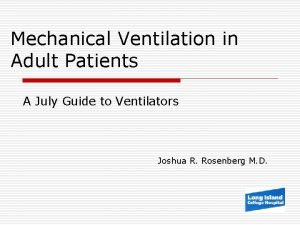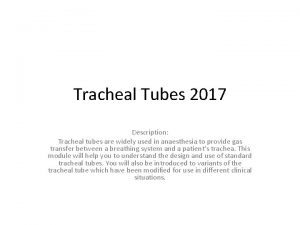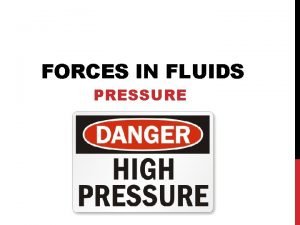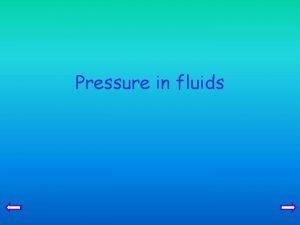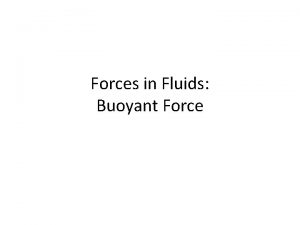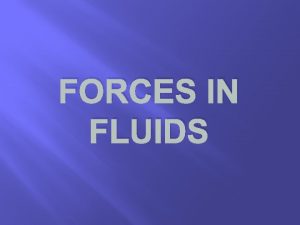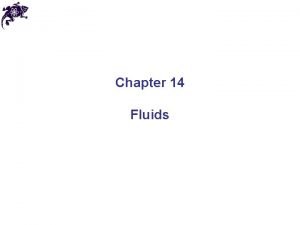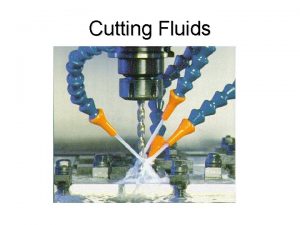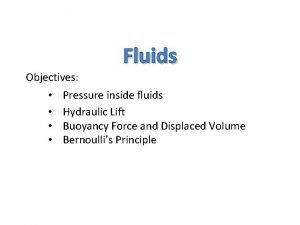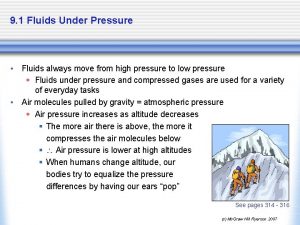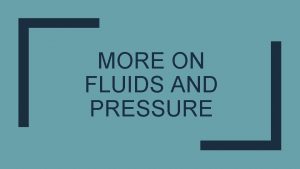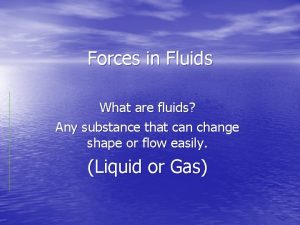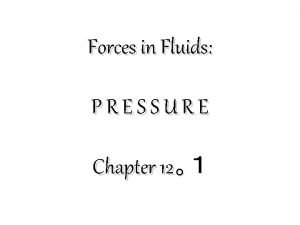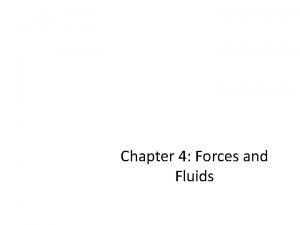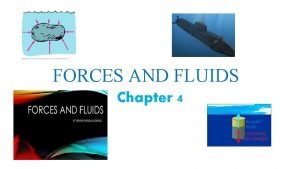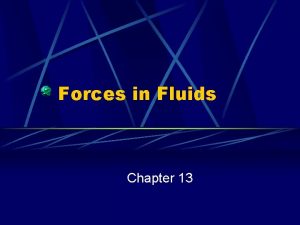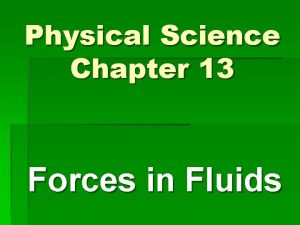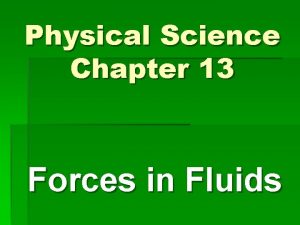Forces in Fluids Chapter 11 11 1 Pressure































- Slides: 31

Forces in Fluids Chapter 11

11. 1 Pressure Ø Pressure & Area -pressure decreases as the area over which a force is distributed increases Pressure = Force Area 1 Pa = 1 N / m² - A Pascal is the unit of pressure

- Pressure What Is Pressure? Ø Pressure decreases as the area over which a force is distributed increases.

- Pressure Area Ø The area of a surface is the number of square units that it covers. To find the area of a rectangle, multiply its length by its width. The area of the rectangle below is 2 cm X 3 cm, or 6 cm 2.

- Pressure Area Ø Practice Problem Ø Which has a greater area: a rectangle that is 5 cm X 20 cm or a square that is 10 cm X 10 cm? Ø Both have the same area, 100 cm 2. Ø 5 cm X 20 cm = 100 cm 2 Ø 10 cm X 10 cm = 100 cm 2

Ø Fluid Pressure -as your elevation increases ↑ atmospheric pressure decreases ↓ Fluid Pressure = Total force exerted by a fluid Area - As your depth in water increases ↓ your pressure increases ↑

- Pressure Fluid Pressure Ø All of the forces exerted by the individual particles in a fluid combine to make up the pressure exerted by the fluid.

- Pressure Variations in Fluid Pressure Ø As your elevation increases, atmospheric pressure decreases.

- Pressure Variations in Fluid Pressure Ø Water pressure increases as depth increases.

11. 2 Floating and Sinking Ø Buoyancy -an object feels lighter in water because the buoyant force is opposite to gravity -The pressure on the bottom of a submerged object is greater than the pressure on the top creating an ↑ upward net force - SINKING – the object’s weight is greater than the buoyant force - FLOATING – the weight of the object is equal to the buoyant force, no net force acts on it.

- Floating and Sinking Buoyancy Ø The pressure on the bottom of a submerged object is greater than the pressure on the top. The result is a net force in the upward direction.

- Floating and Sinking Buoyancy Ø The buoyant force acts in the direction opposite to the force of gravity, so it makes an object feel lighter.

Ø Archimedes’ principle states that the buoyant force acting on a submerged object is equal to the weight of the fluid the object displaces.

Buoyancy Ø A solid block of steel sinks when placed in water. A steel ship with the same weight floats.

- Floating and Sinking Ø Changes in density cause a submarine to dive, rise, or float. Density = mass/volume

11. 3 Pascal’s Principle Ø Fluid Pressure -By changing the fluid pressure at any spot in a closed container you transmit pressure throughout the container - a hydraulic device operates by the movement and force of a fluid Hydraulic Systems -multiply force to a smaller surface area, the increase in pressure is then transmitted to another part of the confined fluid

- Pascal’s Principle Hydraulic Devices Ø In a hydraulic device, a force applied to one piston increases the fluid pressure equally throughout the fluid.

- Pascal’s Principle Hydraulic Devices Ø By changing the size of the pistons, the force can be multiplied.

- Pascal’s Principle Hydraulic Brakes Ø The hydraulic brake system of a car multiplies the force exerted on the brake pedal.

- Pascal’s Principle Comparing Hydraulic Lifts ØIn the hydraulic device in Figure 15, a force applied to the piston on the left produces a lifting force in the piston on the right. The graph shows the relationship between the applied force and the lifting force for two hydraulic lifts.

- Pascal’s Principle Comparing Hydraulic Lifts Ø Reading Graphs: l Suppose a force of 1, 000 N is applied to both lifts. Use the graph to determine the lifting force of each lift. Lift A: 4, 000 N; lift B: 2, 000 N l

- Pascal’s Principle Comparing Hydraulic Lifts Ø Reading Graphs: l For Lift A, how much force must be applied to lift a 12, 000 -N object? 3, 000 N l

- Pascal’s Principle Comparing Hydraulic Lifts Ø Interpreting Data: l By how much is the applied force multiplied for each lift? Lift A: applied force is multiplied by four; lift B: applied force is multiplied by two. l

- Pascal’s Principle Comparing Hydraulic Lifts Ø Interpreting Data: l What can you learn from the slope of the line for each lift? The slope gives the ratio of the lifting force to the applied force. The greater the slope, the more the lift multiplies force. l

- Pascal’s Principle Comparing Hydraulic Lifts Ø Drawing Conclusions: l Which lift would you choose if you wanted to produce the greater lifting force? Lift A, because it multiplies force more than lift B. l

11. 4 Bernoulli’s Principle Ø A fluid naturally flows from an area of high pressure to an area of low pressure Ø The faster a fluid moves the less pressure a fluid exerts

- Bernoulli’s Principle Ø Bernoulli’s principle states that as the speed of a moving fluid increases, the pressure within the fluid decreases.

- Bernoulli’s Principle Applying Bernoulli’s Principle Ø Bernoulli’s principle helps explain how planes fly.

- Bernoulli’s Principle Applying Bernoulli’s Principle Ø An atomizer is an application of Bernoulli’s principle.

- Bernoulli’s Principle Applying Bernoulli’s Principle Ø Thanks in part to Bernoulli's principle, you can enjoy an evening by a warm fireplace without the room filling up with smoke.

- Bernoulli’s Principle Applying Bernoulli’s Principle Ø Like an airplane wing, a flying disk uses a curved upper surface to create lift.
 Science 8- fluids under pressure worksheet answer key
Science 8- fluids under pressure worksheet answer key Liquid pressure unit
Liquid pressure unit Chapter 18 fluids and electrolytes
Chapter 18 fluids and electrolytes Example of like parallel force
Example of like parallel force The forces shown above are pushing/pulling forces
The forces shown above are pushing/pulling forces Intra vs intermolecular forces
Intra vs intermolecular forces Interu
Interu Intramolecular forces vs intermolecular forces
Intramolecular forces vs intermolecular forces Contact force
Contact force Unbalanced force
Unbalanced force Are canyons constructive or destructive
Are canyons constructive or destructive London dispersion
London dispersion Insall salvati ratio
Insall salvati ratio Pressure support vs pressure control
Pressure support vs pressure control Continuous bedside pressure mapping
Continuous bedside pressure mapping Intrapleural pressure
Intrapleural pressure Describing edema
Describing edema Partial pressure
Partial pressure Intrapulmonary pressure
Intrapulmonary pressure Confining pressure vs directed pressure
Confining pressure vs directed pressure Pressure support vs pressure control
Pressure support vs pressure control Bernoulli rule of integration
Bernoulli rule of integration Factors affecting gfr
Factors affecting gfr Impermeance
Impermeance Osmolarity vs osmolality
Osmolarity vs osmolality Oncotic pressure vs hydrostatic pressure
Oncotic pressure vs hydrostatic pressure Confining pressure vs directed pressure
Confining pressure vs directed pressure Mean arterial pressure from blood pressure
Mean arterial pressure from blood pressure How to find partial pressure from total pressure
How to find partial pressure from total pressure What is pressure support ventilation
What is pressure support ventilation Bevel of et tube
Bevel of et tube High pressure area
High pressure area
